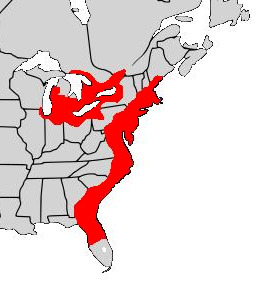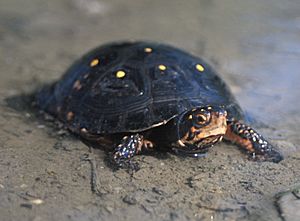Spotted turtle facts for kids
The spotted turtle (Clemmys guttata) is a small turtle found in parts of southern Canada and the United States. You can find them in the eastern Great Lakes area and east of the Appalachian Mountains. These turtles love to live in shallow fresh water places like flooded forests, marshes, wet meadows, and small streams. They are omnivores, meaning they eat both plants and animals.
Quick facts for kids Spotted turtle |
|
|---|---|
 |
|
| Conservation status | |
| Scientific classification | |
| Genus: |
Clemmys
|
| Species: |
guttata
|
 |
|
| Synonyms | |
|
Genus synonymy
Species synonymy
|
|
Contents
What Does a Spotted Turtle Look Like?
Spotted turtles are small, usually growing to about 3.5 to 12.5 centimeters (1.4 to 4.9 inches) long. Their upper shell, called the carapace, is smooth and dark, ranging from gray to black. This shell is covered with bright yellow spots, which is how they get their name! Some turtles have no spots, while others can have up to a hundred.
Their bottom shell, called the plastron, is usually yellow or orange-yellow. Each part of the plastron has a black spot. As the turtle gets older, the black spots can grow and cover the whole bottom shell.
Head and Skin Details
The spotted turtle's head is black with a large orange patch on each side. They also have several yellow bands. The skin on their back is black with a few yellow spots. The skin on their belly can be brighter, like orange, pink, or red. The number and size of spots can change depending on where the turtle lives. Turtles from the south tend to have smaller, less noticeable spots.
How to Tell Males and Females Apart
You can tell male and female spotted turtles apart when they are grown up.
- Males have a tan chin, brown eyes, and a long, thick tail. Their bottom shell is slightly curved inward.
- Females have a yellow chin, orange eyes, and a shorter tail. Their bottom shell is flat or curved outward.
Females are usually a bit larger than males and tend to have more spots on their shells.
Baby Spotted Turtles
Baby spotted turtles, called hatchlings, look a lot like the adults. Each section of their upper shell usually has just one yellow spot.
Where Do Spotted Turtles Live?
Spotted turtles live in a wide area, from southern Maine, Quebec, and Ontario in Canada, all the way south along the eastern US to Florida. They are also found west to central Indiana and Ohio. Some groups of spotted turtles live in separate, smaller areas, like parts of Illinois, Georgia, and the Carolinas.
Favorite Homes for Spotted Turtles
These turtles like many different wet places, such as:
- Swamps and bogs
- Marshes and fens
- Woodland streams
- Wet pastures
- Ditches and temporary pools of water (vernal pools)
A good home for a spotted turtle needs soft ground and some water plants. They especially like shallow, slow-moving water with muddy soil, water lilies, and cattails. Sometimes, their yellow spots help them blend in with plants like duckweed, which often covers the water surface. They usually stay away from deep, open water or man-made lakes.
Spotted turtles also spend time on land. They might warm up in the sun on grassy patches near the water. Female turtles will travel onto land to lay their eggs in sunny soil or even near man-made banks.
Spotted Turtle Populations
In Canada, about 104 groups of spotted turtles have been found in Ontario. However, many of these groups are small and isolated, meaning they don't have enough turtles to keep growing on their own. It's estimated that only about 1,000 to 2,000 spotted turtles live in Canada, and this number is going down.
Spotted turtles often share their homes with other types of turtles, like wood turtles, bog turtles, and painted turtles.
Spotted Turtle Behavior and Life Cycle
Spotted turtles are interesting creatures with unique behaviors. Their sex is determined by the temperature during their development in the egg. This means that warmer temperatures might lead to more females or males being born.
When Are Spotted Turtles Active?
Spotted turtles are most active in the early spring, even when the water is still quite cold. Their busiest time is usually in April and May in the northern parts of their range.
During very cold winters or very hot summers (when water temperatures go above 30 °C or 86 °F), they become inactive. This is called dormancy. In summer, they might burrow into leaves or mud to stay cool and safe. This helps them avoid the heat and also hide from predators.
Home and Safety
Spotted turtles usually stay within a small area, about 0.5 to 3.5 hectares (1.2 to 8.6 acres). Because they are small, they can be easily caught by predators, especially when they are moving on land. Many turtles show scars from past attacks. Raccoons are known to hunt them. If surprised while sunbathing, spotted turtles will quickly dive into the water and bury themselves in the mud at the bottom.
What Do Spotted Turtles Eat?
The spotted turtle is an active hunter. They look for food in the water, often poking their heads into aquatic plants. They eat when the temperature is above 14.2 °C (57.6 °F), which is usually from mid-March until September.
They are omnivores, eating both plants and animals.
- Plant foods include aquatic plants, green algae, and sometimes even wild cranberries.
- Animal foods include insect larvae, worms, slugs, spiders, tadpoles, salamanders, and small fish.
They eat their food, whether it's alive or dead, only when they are in the water. Sometimes, they eat insects that live on land, which suggests they might go onto land to hunt for these. In zoos, they enjoy fruits like cantaloupe and watermelon, as well as fresh or canned fish.
Conservation Efforts
The spotted turtle is facing serious challenges. In Canada, it is listed as an endangered species. In the United States, it is being reviewed for protection under the Endangered Species Act. The IUCN (International Union for Conservation of Nature) also lists it as endangered globally. Many states where it lives have given it special protected status.
Why Are They in Danger?
The main reasons spotted turtle populations are declining are:
- Habitat loss: Their wetlands and forests are being destroyed or changed.
- Pet trade: People illegally collect them to sell as pets.
- Human impacts: Turtles are often hit by cars or lawnmowers.
These threats mean that spotted turtles need help to survive. Protecting their habitats and stopping illegal collection are important steps to ensure these unique turtles continue to thrive.
See also
 In Spanish: Tortuga moteada para niños
In Spanish: Tortuga moteada para niños



